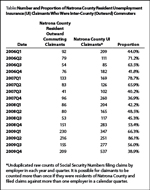Commuting and Unemployment Insurance Claims: Evidence from Natrona County
When employers lay off workers, the effects may be felt in multiple counties. Employment declines at facilities experiencing layoffs and economic activity declines in workers' home counties because of reduced wages. In Wyoming, commuting between counties increased rapidly during the most recent economic expansion (Commuting Patterns Tables: 2004Q1 - 2009Q4, 2010). In a mobile environment, labor markets do not respect county or state boundaries. This article examines Unemployment Insurance (UI) claimants who are residents of Natrona County. The goal is to illustrate workforce mobility and the potential multiple-county impacts of worker dislocations by estimating how many and what proportion of UI claimants residing in Natrona County commuted to another county for work, and subsequently lost their jobs.
The data sets used for this research included the Wyoming UI Claims administrative database and the commuting patterns database. The time span studied was from first quarter 2006 to fourth quarter 2009. The data set was limited to initial or additional UI claimants whose reported physical residence was Natrona County. Commuting workers were counted only if they filed a claim against an employer whose physical address was outside Natrona County. Generally the UI claim counts are unduplicated. However, it is possible a claimant could file against more than one out-of-county employer in a quarter. In those cases, claimants could be counted more than once.
The Table shows the counts of Natrona County residents filing claims and  the number of those claimants who commuted to another county for work (inter-county commuters). The Figure displays the proportion of Natrona County
the number of those claimants who commuted to another county for work (inter-county commuters). The Figure displays the proportion of Natrona County claimants who were inter-county commuters. The proportion exhibited a seasonal pattern from first quarter 2006 and second quarter 2007, peaking at 71.2% in 2006 and 78.7% in 2007. However, the pattern changed beginning in third quarter 2007 when the rate declined to 40.2% compared to 63.5% in the prior year. The change in pattern continued through 2008 and the first two quarters of 2009. The peak rate of 86.1% occurred in second quarter 2009.
claimants who were inter-county commuters. The proportion exhibited a seasonal pattern from first quarter 2006 and second quarter 2007, peaking at 71.2% in 2006 and 78.7% in 2007. However, the pattern changed beginning in third quarter 2007 when the rate declined to 40.2% compared to 63.5% in the prior year. The change in pattern continued through 2008 and the first two quarters of 2009. The peak rate of 86.1% occurred in second quarter 2009.
The table and chart show that during times of rapid economic expansion (late 2007 to mid-2008), the proportion of commuter-claimants declined substantially. Conversely, the opposite event took place when job growth ceased and began to decline in 2009. The data illustrate that a considerable portion of more recent UI claimants living in Natrona County were laid off from jobs in another county. As a result, the economic health of Natrona County was adversely impacted by events in other counties.
For more information, contact Douglas W. Leonard at (307) 473-3811 or dleona@state.wy.us.
References
Wyoming Department of Employment, Research & Planning (2010). Commuting patterns database. Unpublished raw data.
Wyoming Department of Employment, Research & Planning. (2010). Commuting Patterns Tables: 2004Q1 – 2009Q4. Retrieved July 27, 2010 from http://doe.state.wy.us/LMI/commute.htm
Wyoming Department of Employment, Research & Planning (2010). Unemployment insurance claims database. Unpublished raw data.
